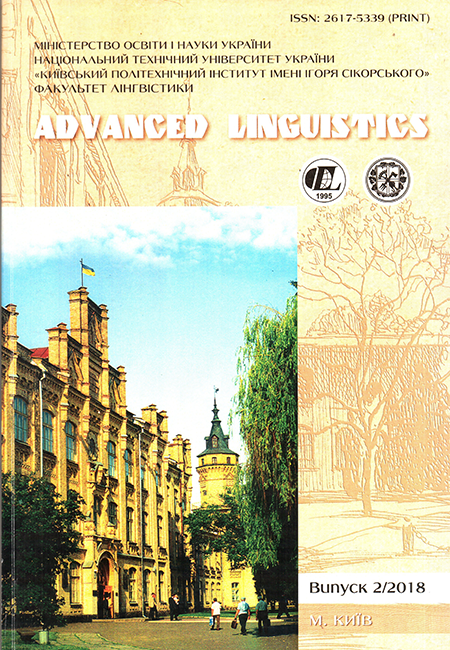CORPUS METHODS AS AN ADVANCED SOLUTION FOR TECHNICAL TRANSLATION QUALITY IMPROVEMENT
DOI:
https://doi.org/10.20535/2617-5339.2018.2.158370Ключові слова:
original text, target text, corpus methods, nuclear corpus, corpus manager, AntConc, translation quality.Анотація
This article is devoted to the investigation of the main problems encountered by technical translatorswhile translating engineering texts and provision of an alternative solution for them to eliminate translation weaknesses, improve quality, and optimize translation itself.The article defines features of a good quality translation and its requirements.In addition, the ways to overcome various translation difficulties at syntactic, semantic and structural levels are given in the form of recommended translation techniqueswhich are classifiedaccording to specified criteria.The research paperalso provides a practical example of technical translation, the analysis which gives wide opportunities for studying a corpus as an alternative solution for improving thequality of the translation. The article presents types and criteria for a good corpus compilation. Practical usage of a corpus with examples is suggested to outline its main functions and opportunities which can assist any translator in achieving the closest equivalency and adequate translation. The following paper shares experience of developing the Nuclear Corpus and its successful implementationwhile using the most user-friendly corpus managers. The article also demonstrates the advantages of corpus application during translation compared to other modern technologies used in the process of translation. This research encouragesthe idea of further corpus development for the specific translation needs in order to make target texts equivalent at the highest level and meet expectations of the addressees. At the same time, the article makes it possible to study the issue of a corpus further with the purpose to identify new useful opportunities it can provide to facilitate the work of a translator.
This article is devoted to the investigation of the main problems encountered by technical translatorswhile translating engineering texts and provision of an alternative solution for them to eliminate translation weaknesses, improve quality, and optimize translation itself.The article defines features of a good quality translation and its requirements.In addition, the ways to overcome various translation difficulties at syntactic, semantic and structural levels are given in the form of recommended translation techniqueswhich are classifiedaccording to specified criteria.The research paperalso provides a practical example of technical translation, the analysis which gives wide opportunities for studying a corpus as an alternative solution for improving thequality of the translation. The article presents types and criteria for a good corpus compilation. Practical usage of a corpus with examples is suggested to outline its main functions and opportunities which can assist any translator in achieving the closest equivalency and adequate translation. The following paper shares experience of developing the Nuclear Corpus and its successful implementationwhile using the most user-friendly corpus managers. The article also demonstrates the advantages of corpus application during translation compared to other modern technologies used in the process of translation. This research encouragesthe idea of further corpus development for the specific translation needs in order to make target texts equivalent at the highest level and meet expectations of the addressees. At the same time, the article makes it possible to study the issue of a corpus further with the purpose to identify new useful opportunities it can provide to facilitate the work of a translator.
##submission.downloads##
Номер
Розділ
Ліцензія
Наше видання використовує положення про авторські права CREATIVE COMMONS для журналів відкритого доступу.
Автори, які публікуються у цьому журналі, погоджуються з наступними умовами:
1. Автори залишають за собою право на авторство своєї роботи та передають журналу право першої публікації цієї роботи на умовах ліцензії Creative Commons Attribution License, котра дозволяє іншим особам вільно розповсюджувати опубліковану роботу з обов'язковим посиланням на авторів оригінальної роботи та першу публікацію роботи у цьому журналі.
2. Автори мають право укладати самостійні додаткові угоди щодо неексклюзивного розповсюдження роботи у тому вигляді, в якому вона була опублікована цим журналом (наприклад, розміщувати роботу в електронному сховищі установи або публікувати у складі монографії), за умови збереження посилання на першу публікацію роботи у цьому журналі.

